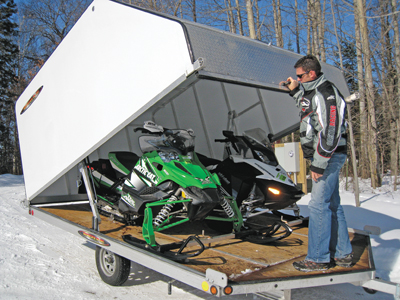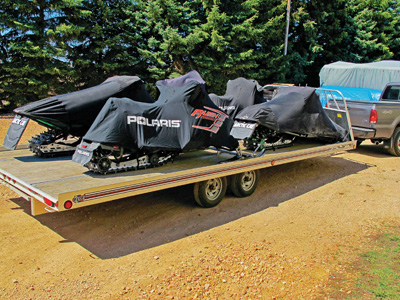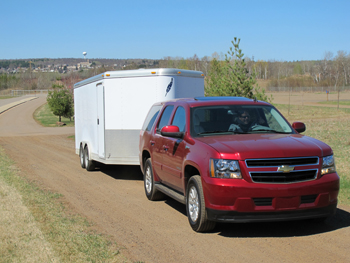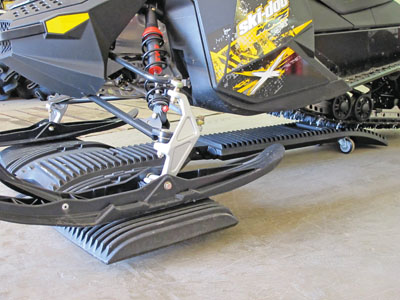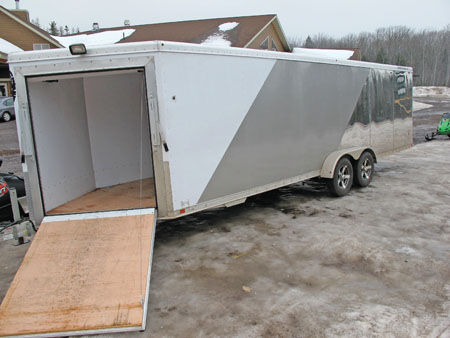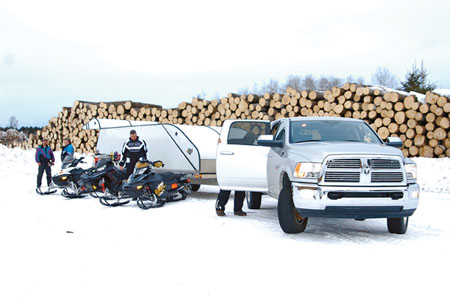Most trucks come with towing packages and leave the factory tow-ready, often with transmission coolers, upper-class receiver hitches and seven-pole connectors ready for use. Recently, most fuse panels on these vehicles are pre-wired for a brake control box addition. This makes it easy to mount and plugin an electronic brake control box and hit the road better equipped for heavier loads. Ford has gone the extra step. Its Tow Command feature is a factory installed electronic brake controller integrated into the dash. It was the Tow Command feature we wanted to test most. We contacted Ford, and a few weeks later a 2006 Ford F-250 4×4 Crew Cab Super Duty appeared in our lot with the Tow Command hardware. This was a truck made for towing.
The 2006 Ford F-250 4×4 Crew Cab we had for our test was the King Ranch edition. Eighteen-inch wheels, lighted running boards and special exterior trim comes with that package. Other exterior upgrades, from the lesser Lariat package, were also on the truck, including chrome bumpers, front tow hooks and fog lamps, a chrome grille with jewel effect headlamps and privacy glass. Our King Ranch was dipped in a dark copper clearcoat, and accented with a color Ford calls Arizona Beige, keeping the ranch theme.
Ford Motor Co. gave its Super Duty F-Series trucks a list of upgrades for the 2005 model year. It included more than a nose job, too. In addition to the updated styling, which remained tough and chiseled-looking, Ford strengthened the frame and updated its powertrain for improvements more than skin deep.
The Super Duty frame, including the F-250 (three-quarter-ton) and F-350 (one-ton) trucks, featured a new fully boxed front section. Ford said it improved strength and torsional stiffness. From the boxed section rearward, the frame used steel that is 10 to 17 percent thicker, with additional gussets providing even more strength and durability in high-stress areas.
Ford brags that it uses the thickest gauge steel in any pickup. Stiff framework is a necessity for heavy-duty trucks, and with its new F-Series, it seems the company is in overdrive. That tough frame is a benefit for towing, too.
Also for 2005, Ford upgraded its Triton V10 for more power. The three-valve-per-cylinder head configuration, introduced on the 2004 Ford F-150, was adapted to the Triton V10 to increase its claimed power output. That engine is now in its second model year, and was in our test vehicle.
With the redesign of 2005, the Super Duty trucks had only a list of cosmetic and package updates such as new colors and different wheel options for 2006.
The interior space on the Super Duty F-Series is among the best of crew cab trucks. There is abundant head room with 41.3 inches. Overall there are 41 inches of front passenger legroom and 41.7 inches of leg room for rear seated passengers. Our test vehicle included a powered moonroof and a power-rear-sliding window in its options group.
The interior configuration on our King Ranch had four captains chairs inside its four full-size doors. Front seats were six-way power with lumbar support, were wrapped in brown leather and were heated for a quick warm-up after a winter chill sets in from a long day on the trail.
Front and rear seating had a large center console between the leather thrones, complete with storage and beverage holders. The rear seating was a great arrangement for a truck that takes several road trips with four passengers, but there is a conventional 60/40-split rear bench seat as standard equipment. The bench folds for interior rear storage, and is a likely preference for most truck owners.
The instruments are basic but inform operators of all the critical functions. More specific for towing, a transmission temperature gauge is included to monitor the heat when working the driveline.
While not great, the resultant fuel usage was 10.9 mpg during normal driving consisting of combined urban and highway use. That figure isn’t all that bad considering the engine fires 10 pistons, and this truck was made to pull.
The Most Tow-Ready Trucks Yet
Ford has a variety of engine options for its Super Duty F-Series trucks. Our 2006 Ford F-250 4×4 Crew Cab was equipped with the powerful — albeit thirsty — 6.8 liter, three-valve Triton V10. Its appetite for fuel is both expected and excused. Filling the tank is the tax for its 355 hp and 455 pound-feet of torque.
The transmission was the TorqShift five-speed automatic. The final drive ratio was a stout 4.30 axle. The gearing is such that to get a load moving is no chore whatsoever. First gear is a short 3.11:1 ratio. The five-speed tranny shifts quickly to second for a 2.22:1 drive and third — when acceleration and power is most critical — is 1.55:1. The first three gears shift quickly, and the power of the V10 pulls through them effortlessly without a trailer.
Towing is where the brut strength of the 2006 Ford F-250 4×4 Crew Cab Super Duty is evident. The torque of the Triton V10 is noticeable in hilly situations. Approaching grades at highway speeds, the truck did not downshift or lose speed on grades of about 5 percent. Even accelerating on inclines in the tow/haul mode did not cause acceleration to stall. The F-250 stayed in its peak powerband longer, as it should, and kept pulling to our desired speed. At highway speeds between 70 and 75 mph, the engine plugged along at about 2200 rpm.
Our combined vehicle weight on a public scale, including the truck, the fuel on board, the loaded trailer and the driver was 12,460 pounds. We estimated the trailer weight at 5,600 pounds after deducting the estimated curb weight (6,800 pounds) of the truck, driver and miscellaneous payload.
By no surprise, a purposeful workhorse pulls a trailer with little impact to its road manners. The thick, sturdy frame, rugged progressive leaf spring rear suspension components and the light-truck, all-terrain tires provided a competent, stable truck that didn’t wander or squat. Like a lot of 3/4-ton vehicles, it drove better while loaded.
The TorqShift had one of the better tow/haul modes we’ve tested. Like all of these modern systems, the towing mode prolonged the shift points to keep the engine in its most powerful range longer. It slowed the shifting when mated to our enclosed trailer, but acceleration was smooth and effortless, though more engine noise came through the firewall and floor than we prefer.
The tow/haul mode was both fun and useful in traffic. When stopped at a stoplight, we observed traffic from behind moving into the other lane to avoid having forward progress delayed. We suppose that people thought getting the truck and the trailer moving from a dead stop would add precious seconds to the commute, so they moved out from behind. That attitude insults this truck. To maintain the Ford’s honor, we out-accelerated the import sedans that were in the other lane.
The transmission was even more useful and real-worldly in its workin’ mode while off the throttle. The drive system senses when a driver is coasting the vehicle and holds gears or downshifts accordingly, adding a welcome dose of engine braking when approaching stops or descending hills. During braking, the downshifting is abrupt, but not harsh. It feels sturdy and rugged, like most other driveline components on the truck.
In Command Of The Load
While it’s a $205 option, anyone who plans to pull a trailer and specs out a Super Duty would be foolish not to include the Tow Command on the build sheet. It works like an accessory electronic unit, with controls to adjust trailer braking force, and brakes on the load behind can be manually applied as well.
Ford’s system is smarter than an accessory box, however. Because the box is integrated into the main wiring harness and vehicle computer, the brake controller knows how fast the vehicle is traveling and adjusts the braking force accordingly. It also senses brake force applied to the truck, and it knows when the truck’s anti-lock brake system activates for improved control on surfaces with reduced traction. Those features won’t be in a box from the auto parts store.
The Tow Command is the smoothest brake controller we’ve ever used. We’re used to the progressive trailer braking with accessory units, in which more braking force is activated to the load and the drag is felt from behind. Not so with the Tow Command. All our stops were smooth, without the pulled-from-behind feeling from our trailer that we experience with other controllers, whether we had the trailer brakes set to minimum or maxed out. Trailer braking force is indicated with LED lights on the console.
The memory on the Tow Command is a nice plus. Unlike the tow/haul switch on the gear selector that defaults to normal mode when the engine refires, the brake controller will come back online with the settings last used if a trailer stays connected.
The mirrors on the tow package are first-rate, too. While wide to start with, the mirrors telescope to extend rearward reach farther. With the mirrors extended, we had the best rearward visibility around our enclosed four-place trailer we’ve ever experienced.
While performing the effortless towing, the truck indicated an average of 8.2 mpg on its dash trip computer, but we did the math as a backup and revealed the dash computer was a bit optimistic. Our calculations revealed an overall 7.9 mpg while towing, but the trip computer was in the ballpark. The quick dashes off the line to beat the Honda Civics were not included in that fuel summary.
2006 Ford F-250 4×4 Crew Cab Comfort:
The interior was quiet and comfortable save the engine noise under load, though every bump in the road reminded us we were driving a stiffly sprung truck. The rear axle had some hop on the severe bumps, but not enough to cause handling disturbances. With a loaded bed or a heavy tongue weight, it faded.
The truck has length as an enemy for practical driving situations, but that is inherent in the design and function of the truck. For its 156.2-inch wheelbase, the truck had a reasonable turning circle at 51.8 feet. Also, if keeping the vehicle out of the elements when not in motion is a priority, have a long garage in which to park it. The overall length is 20.5 feet.
Overall, the Ford F-250 Super Duty was one of the most towing-focused vehicles we’ve tested. There is a reason people encounter so many Super Duty F-Series trucks on the road. Normal driving is civilized, and in many ways they perform better when hauling and pulling — what they are meant to do.
As for the innovative Tow Command, we expect other manufacturers to follow suit with an integrated towing controller of their own, because it’s such a great feature. It’s also what positions the Super Duty trucks as the most towing-oriented trucks yet from a factory.

